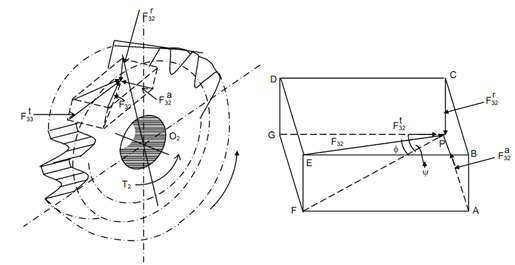Force Analysis in Helical Gears:
A helical gear can be left handed or right handed. Figure 3(a) illustrated a left handed helical gear. It might be a driver or driven gear. Let us consider that this is a driver gear. The normal force on the tooth F32 may be resulted in three components as radial tangential, and axial. It can be supposed to be acting along with the diagonal of a parallalopiped. The parallelopiped is illustrated by dotted lines along one corner at the pitch point. It is illustrated enlarged in Figure 3(b). The normal reaction on the tooth F32 has been illustrated along the diagonal EP. The angle EPF is equivalent to the pressure angle 'φ' & ∠ GPF in the horizontal plane shall be equivalent to the helix angle 'ψ'. The components will be along the lines GP, CP and AP, respectively. Initially force 'F32' can be resolved in the vertical plane passing by the lines FP & CP.
will be along the lines GP, CP and AP, respectively. Initially force 'F32' can be resolved in the vertical plane passing by the lines FP & CP.

(i) (ii)
Figure 3 : Helical Gear Forces
Hence, the radial component
 . . . (4)
. . . (4)
Here φ is normal helix angle.

∠GPF = Helix angle ' ψ '
Hence, the tangential component is given by following
 . . . (5)
. . . (5)
The axial component is given by following
 . . . (6)
. . . (6)
As explained in the last section, the tangential component may be estimated from driving torque and tooth load may be measured from it. So,
 . . . (7)
. . . (7)
 . . . (8)
. . . (8)
and
 . . . ( 9)
. . . ( 9)